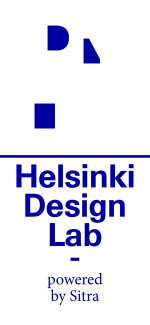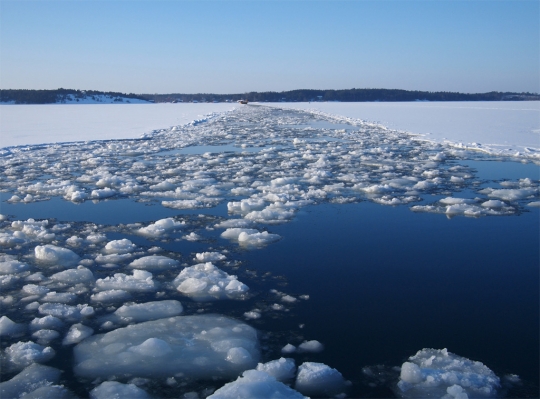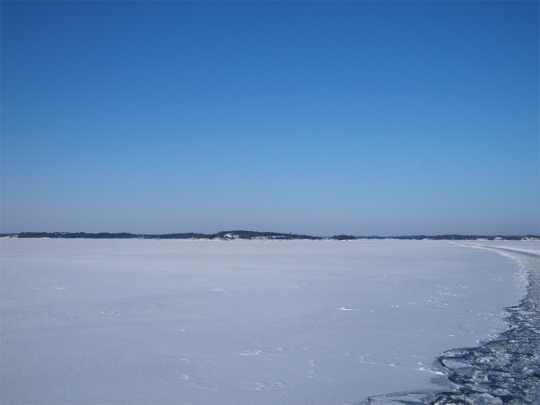If you look very very closely at the photo above, you'll see a string of windmills on the horizon, set against the perfect blue sky. This is Högsåra, an island that forms a small part of the archipelago that stretches from Hanko to Turku in south-western Finland.
We're here to better understand the local decision-making cultures and stories - to explore how these wind turbines got up, including the resistance to them as well as those in favour. But our focus isn't wind power per se; we're looking at this case as it helps frame the wider debates about how to transition Finland to a more sustainable 'bio-economy', as our colleagues in Sitra's Maamerkit ('Landmarks') programme call it.
So we're interested in how communities might balance the desires of individuals with the desires of the wider community, the role of authorities and institutions as well as communities and industry, how we might reorient elements of bureaucracy such that they are more 'user-centred', how to use the powerful enablers of new communications platforms, alllied to the increased appetite for local engagement in decision-making, and so on.
We've also been to the port of Hamina in eastern Finland, towards the Russian border, as described by Bryan a couple of weeks ago. In both Hamina and around Högsåra, we interviewed several of the key protoganists in both stories. More to follow.
Our expedition team - currently Bryan, Karoliina Auvinen, and Nina the interpreter (who in Rosala was translating in three languages simultaneously: English, Swedish and Finnish!) - visited both places. As a side note, in a country as big as Finland and with a history as rich as Finland, it's fascinating for a mere immigrant like me to observe the differences between the Swedish-speaking western Finland as compared to the influence of Russia to the eastern side, and then with Helsinki, where we're based, caught in the middle. There are numerous cultures of decision-making at play here, even in a country of only 5.5m people.
Developments like wind farms, which can often be contentious for some, place these decision-making cultures under a microscope. But we'll also be roving around Finland a little, looking at other case studies, as well as exploring international examples of new kinds of decision-making that might enable more resilient economies - in the widest sense of the word 'economy'.
And then we will be building something, working with some local communities in Finland, perhaps prototyping a new kind of decision-making. Please do send us any examples you think might be relevant - it's a broad topic, so there is no chance we'll have all the right angles covered, particularly at this stage.
(From an organisational point-of-view - not that you need care! - it's also gratifying to see three Sitra teams (us at Strategic Design, Maamerkit and Energia) coming together for this project, as it helps flesh out how our new organisational model might work, with a new emphasis on doing projects, run by multi-facted project teams within broad and connected focus areas. It also builds on a long-term interest of mine in civic participation, which I summarised in this entry on 'emergent urbanism' a couple of years ago. My now colleague Bryan had, unbeknowst to me, started working on similar themes, building on the promise of Kickstarter. I would then build on this idea of 'a Kickstarter for development of shared spaces and resources', dubbing it Brickstarter, our informal working title for a while. Meanwhile, our colleagues in Maamerkit were also getting interested in terms of how to turn NIMBY into YIMBY, as regards bio-economy development. All these threads have now converged in this project. Funny how things work out.)
The other reason to mention Högsara - and Kasnäs and Rosala - is that it was startlingly beautiful. A simply stunning day, with endless blue sky over endless snow-covered frozen sea. Sadly, the Baltic is now so polluted that the traditional trade of fishing is no longer tenable here (at a Mistra event in Sigtuna, I heard the director of the European Environment Agency clearly outlined it was a matter of 'when' not 'if' the Baltic will collapse.) So, as beautiful as the area still is, the place needs to find new opportunities for locals. It's hard to credit when you're faced with these pristine images, which hardly do justice to the scene, but there are significant challenges facing these small dispersed communities, amidst the other 190,000 islands around the coast of Finland. Another reason why this project is fascinating.
In other news, the 'Helsinki Street Eats' book nears completion - yet again! But we're close now. And our discussions with the City of Helsinki over street food are getting interesting. It looks like this NIMBY>YIMBY project above will be joined by work in food entrepreurship as major new projects this year, alongside the existing Design Exchange, Low2No and Helsinki Design Lab.
And just on Design Exchange, Sara Ikävalo, the designer that we've worked with City of Lahti to 'place' into a forthcoming urban development project, joined Marco and I for a good planning session on Monday. She's hit the ground running and we're working on getting a blog together for that project too - there's already plenty to report. I'll skip the details for now, but - quietly and steadily - Design Exchange is one of our most radical projects in a way; placing strategic designers at the heart of government. A real test! More to follow, though, as Sara is already making a difference.
A good, productive week.







